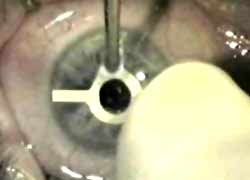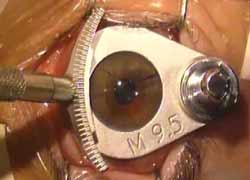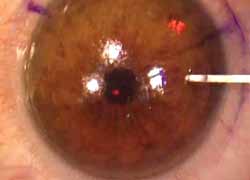Details help improve outcomes in LASIK
Experienced surgeon gives advice on how to master all stages of the procedure.
|
|
|
|
|
|
Attention to the details of surgery, from proper positioning of the patient to careful replacement of the flap, can affect the outcomes of LASIK, an experienced surgeon said.
LASIK is a well-consolidated, standardized procedure. “We have both the theory and the practice that allow all of us to perform it well and safely,” said Lucio Buratto, MD. In reviewing the stages of the procedure, he focused on details that can improve quality and results and prevent complications.
Preliminaries
Before the procedure, the patient must be carefully positioned, Dr. Buratto said. The patient’s head and neck must be relaxed, straight and in line with the rest of the spinal column. The chin should not be tilted upward or downward.
“Many cases of decentration and inaccurate results could be avoided by just checking that the patient is correctly positioned right from the beginning of the procedure,” he said.
Corneal marking can be done with different kinds of markers. Dr. Buratto recommended markers with bulb stabilizers for better precision.
“Marking gives the reference points for repositioning the flap, and a well-positioned flap means the avoidance of folds and a better functional quality for the patient,” he said.
Dr. Buratto said astigmatic marking is useful when there is a high degree of astigmatism. It should be made on the 0° to180° axis.
Flap making
During the first stages of the procedure, it is important to prevent corneal disepithelialization. This can be achieved by wetting the cornea and the microkeratome blade with anesthetic to help the blade slide smoothly, said Dr. Buratto. To increase the effects of the anesthesia, an additional drop can be instilled on the conjunctiva once the speculum has been positioned in the eye.
For better centration of the flap, the microkeratome ring should be positioned on the cornea using both hands, centering it on the pupil and pushing it toward the bulb, he said. Suction can then be applied.
A new blade should be used for each eye, or if that is not possible, at least for each patient.
“Although the blade is new, always check it under the microscope before using it,” Dr. Buratto said.
Modern microkeratomes have enhanced safety features, he said. However, a microkeratome block occasionally may occur during the cut due to electrical problems or problems with the pedal.
“If this happens, suction should not be immediately released. Maintain suction levels and disassemble the microkeratome. It is the best you can do for the cornea,” Dr. Buratto said.
Flap raising
After the cut has been performed, the flap can be raised using forceps, a surgical sponge or a spatula.
“This is a very delicate stage of the procedure because we don’t want to damage the flap or alter its quality by using inappropriate instruments. Blunt, nontraumatic forceps or special spatulas are available and make the maneuver much safer,” Dr. Buratto said.
The spatula should be introduced between the center of the flap and the hinge. From this position, the flap is delicately lifted. Incorrect positioning and use of the instrument may cause damage to the flap with disappointing functional results, he said.
In case of torn flaps, the surgeon should not attempt to continue the procedure, Dr. Buratto said.
“The best thing to do is to replace the flap and waiting for 3 months. By then, if no other traumatic maneuvers are performed, the cornea will have had the time to heal and will be ready for a new treatment,” he said.
Laser ablation
Before laser ablation, fluency and centration should always be checked.
“The plate should turn red in a uniform manner, the circles should be perfectly round and the eye tracker always well centered on the spot,” Dr. Buratto said.
In case of nystagmus, the use of an eye tracker becomes mandatory, and treatment should be performed keeping the suction ring on the eye.
Dr. Buratto advocated the choice of wavefront-guided treatment, both for primary and secondary LASIK procedures.
“It gives us the possibility of removing less tissue and, at the same time, obtaining larger optical zones. By reducing the induction of aberrations and reducing the preoperative ones, we improve our results, giving the patient a better quality of vision,” he said.
During ablation, the flap should be protected with a special flap shield. Older methods, such as protecting the flap with a Merocel sponge, are less safe, he said.
Flap repositioning
When replacing the flap, corneal marks should perfectly coincide, and no space should be left between the edge of the flap and the cornea, Dr. Buratto said. For better adhesion, wet the flap and apply it on a dry stroma, or wet the stroma and apply on it a dry flap, he said.
“If the flap is folded, raise it, unfold it and reposition it. Don’t change this sequence, if you don’t want to make the maneuver more complicated and traumatic for the flap or the stroma,” he said.
Dr. Buratto also predicted some advances of the technique.
“We can still improve diagnosis and patient selection,” he said. “We expect flap performance to become even safer with the use of laser for the cut. Customized wavefront treatment will be perfected by increasingly sophisticated software, and we’ll be developing new methods for the control of healing processes.”
For Your Information:
- Lucio Buratto, MD, can be reached at Piazza della Republica 21, 20124 Milan, Italy; +(39) 02-636-1191; fax: +(39) 02-659-8875; e-mail: office@buratto.com.



